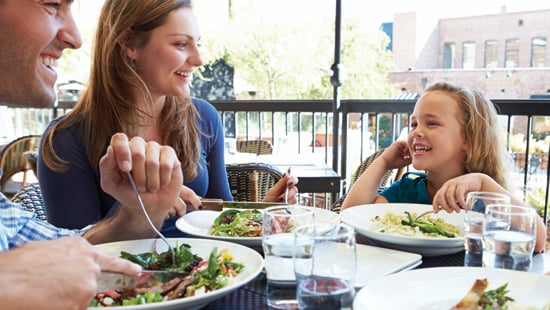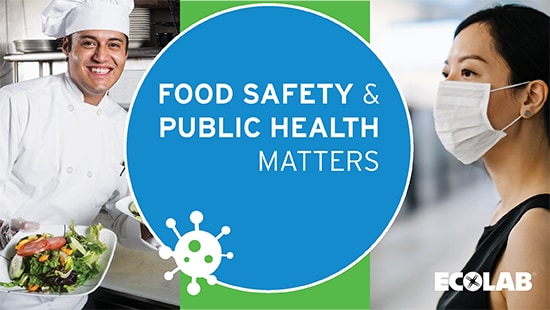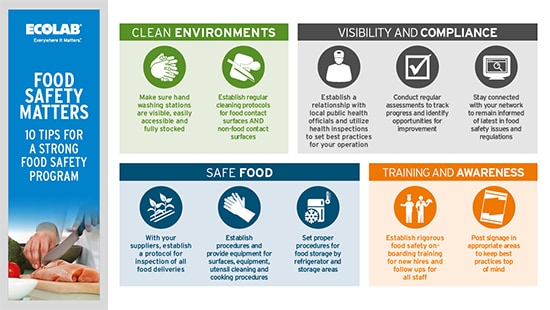Going Beyond Food Safety

The global burden of foodborne disease is substantial. Every year, foodborne diseases cause;
- Almost 1 in 10 people to fall ill
- 33 million healthy life years lost
- 420,000 deaths
- Children account for almost 1/3 of deaths from foodborne diseases
Food safety practices and behaviors are good business. It impacts other areas of the restaurant, including improved food safety, increased profitability, reduction of food waste, helping to ensure guest and employee safety, increase guest satisfaction and protection of your brand and reputation.
Food safety practices and behaviors are good business. It impacts other areas of the restaurant, including improved food safety, increased profitability, reduction of food waste, helping to ensure guest and employee safety, increase guest satisfaction and protection of your brand and reputation.
Ecolab’s latest food safety webinar ‘Going Beyond Food Safety’ presented by Mandy Sedlak, RS/REHS Food Safety and Public Health Manager with EcoSure, a Division of Ecolab is now available.
This webinar takes a closer look at how foodservice operations can make food safety personal for their staff, guests and stakeholders through current trends in the industry. Knowing current trends and how they impact food safety and food operations will help drive best practices in your operation, which protect your guests, the community and ultimately your brand.
One of the major trends impacting food safety and practices at present is the increasing consumer demands for convenience in food delivery adding new food safety and operational challenges for food service operations. In the US, restaurant delivery is projected to grow more than 3x the rate of on-premise sales by 2023; in 2020, 70% of customers will order food off premises. The need to maintain foundational food safety practices is even more important.
Food safety practice 1: Cooking, holding, cooling and reheating in a full capacity kitchen
- Cooked Foods
- Orders must be cooked and held at the recommended temperatures to kill pathogens.
- Do not rush orders through without checking final cooked food temperatures.
- Holding
- Hot food should be held at >135°F (57°C) and cold food should be held at <41°F (5°C).
- Production, line, assembly and staging hot and cold holding equipment must be functioning properly.
- Cooling
- Cool food in shallow pans to <70°F (21°C) within 2 hours and <41°F (5°C) within an additional 4 hours.
- Maintain a depth of 3 inches or less for optimal cooling.
- Reheating
- Reheat products to 165°F (74°C) within 2 hours.
- The timing and temperatures of this process is of utmost importance.
- Monitor and document the process; moving through the danger zone quickly. The danger zone is anywhere in between 42°F (6°C) and 134°F (56°C).
Food safety practice 2: Personal hygiene and hand washing remains important for everyone involved in the delivery process
- Food Handlers should not work with symptoms of vomiting or diarrhea.
- There should be no bare hand contact with Ready to Eat food. Use the proper tools, such as tongs or gloves, to prevent bare hand contact.
- Excellent handwashing—ensure hand washing sinks are easily accessible, stocked and functioning.
- Reduce barriers to handwashing such as a blocked sink or a sink with no paper towels or soap.
Delivery Considerations
Packaging helps set the tone for the guest experience upon delivery and should focus on food safety, food security and food quality. Tamper resistant seals are a best practice to put in place for security. Use strong bags or double bags to withstand different traveling conditions. Package hot food hot and cold foods cold to maintain proper temperatures for safety and quality. Also think about affixing labels with information educating the customer around when the meal was prepared and proper heating/reheating instructions.
Click below to watch the webinar in full and learn more about the current trends impacting food safety and food operations today and best practices you can put in place to protect your guests, the community and ultimately your brand.
For further information or resources to help you minimise your food safety risks please visit our food safety matters page.
Related Articles
Additional Resources

On-Demand Food Safety Webinars
Did you miss one of our earlier Food Safety Matters webinars? Stay up-to-date here and listen to our experts present topics surrounding the diverse aspects of food safety.

Food Safety Resources
Download our latest food safety materials to help you establish a strong food safety programme, enhance a culture of food safety within your operation and keep your staff and customers safe.

